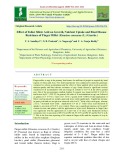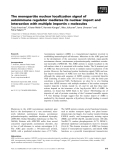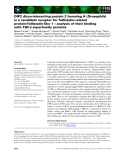
Disease tolerance
-
Finger millet or ragi is the primary food source for millions of people in tropical dry land regions of Africa and Asia. Two field experiments were conducted to study the genotypic variation for silicon accumulation and the effect of foliar applied silicic acid on growth, nutrient uptake and blast disease resistance of ragi. Study showed a significant varietal variation for Si accumulation with an average Si content of 1.67 % in the above ground part.
 11p
11p  angicungduoc6
angicungduoc6
 22-07-2020
22-07-2020
 13
13
 3
3
 Download
Download
-
Autoimmune regulator (AIRE) is a transcriptional regulator involved in establishing immunological self-tolerance. Mutations in theAIREgene lead to the development of the autosomal, recessively inherited, organ-specific autoimmune disease, autoimmune polyendocrinopathy candidiasis ectoder-mal dystrophy (APECED).
 10p
10p  dell39
dell39
 27-03-2013
27-03-2013
 36
36
 2
2
 Download
Download
-
Follistatin-related protein (FRP)⁄follistatin-like 1 (FSTL1) is a member of the follistatin protein family, all of which share a characteristic structure unit found in follistatin, called the FS domain. Developmental studies have suggested that FRP regulates organ tissue formation in embryos. Immunological studies showed that FRP modifies joint inflammation in arthritic disease, and modu-lates allograft tolerance.
 12p
12p  viettel02
viettel02
 19-02-2013
19-02-2013
 31
31
 4
4
 Download
Download
-
Tilapia tolerate adverse water quality and other stressors better than most other commercial aquaculture species. Because stress and environmental quality play such important roles in the disease process, tilapia are labeled as being very "disease-resistant." This basically means that in the presence of pathogens, tilapia are the last to break with disease.
 13p
13p  vachmauthu5_2305
vachmauthu5_2305
 10-04-2011
10-04-2011
 112
112
 6
6
 Download
Download
-
Stages I and II Seminoma Inguinal orchiectomy followed by retroperitoneal radiation therapy cures ~98% of patients with stage I seminoma. The dose of radiation therapy (2500– 3000 cGy) is low and well tolerated, and the in-field recurrence rate is negligible. About 2% of patients relapse with supradiaphragmatic or systemic disease. Surveillance has been proposed as an option, and studies have shown that about 15% of patients relapse. The median time to relapse is 12–15 months, and late relapses (5 years) may be more frequent than with nonseminoma.
 6p
6p  konheokonmummim
konheokonmummim
 03-12-2010
03-12-2010
 60
60
 4
4
 Download
Download
-
Non-Small Cell Lung Cancer NSCLC Stages I and II Surgery In patients with NSCLC stages IA, IB, IIA and IIB (Table 85-2) who can tolerate operation, the treatment of choice is pulmonary resection. If a complete resection is possible, the 5-year survival rate for N0 disease is about 60–80%, depending on the size of the tumor. The 5-year survival drops to about 50% when N1 (hilar node involvement) disease is present. The extent of resection is a matter of surgical judgment based on findings at exploration.
 5p
5p  konheokonmummim
konheokonmummim
 03-12-2010
03-12-2010
 88
88
 7
7
 Download
Download
-
Small Cell Lung Cancer A simple two-stage system is used. In this system, limited-stage disease (seen in about 30% of all patients with SCLC) is defined as disease confined to one hemithorax and regional lymph nodes (including mediastinal, contralateral hilar, and usually ipsilateral supraclavicular nodes), while extensive-stage disease (seen in about 70% of patients) is defined as disease exceeding those boundaries. Clinical studies such as physical examination, x-rays, CT and bone scans, and bone marrow examination are used in staging.
 6p
6p  konheokonmummim
konheokonmummim
 03-12-2010
03-12-2010
 85
85
 5
5
 Download
Download
-
Decision-making for the implementation of specialized nutrition support (SNS). CVC, central venous catheter; PICC, peripherally inserted central catheter. (Adapted from previous chapter by Lyn Howard, MD.) The first step in deciding to administer SNS is to consider the nutritional implications of the disease process. Is the condition or its treatment likely to impair food intake and absorption for a prolonged period of time? For example, a well-nourished individual can tolerate approximately 7 days of starvation while experiencing a systemic response to inflammation (SRI).
 5p
5p  konheokonmummim
konheokonmummim
 03-12-2010
03-12-2010
 87
87
 5
5
 Download
Download
-
Thyroid Disease (See also Chap. 335) In pregnancy, the estrogen-induced increase in thyroxine-binding globulin causes an increase in circulating levels of total T 3 and total T4. The normal range of circulating levels of free T4, free T3, and thyroidstimulating hormone (TSH) remain unaltered by pregnancy. The thyroid gland normally enlarges during pregnancy. Maternal hyperthyroidism occurs at a rate of ~2 per 1000 pregnancies and is generally well tolerated by pregnant women. Clinical signs and symptoms should alert the physician to the occurrence of this disease.
 6p
6p  ongxaemnumber1
ongxaemnumber1
 26-11-2010
26-11-2010
 108
108
 5
5
 Download
Download
CHỦ ĐỀ BẠN MUỐN TÌM





















